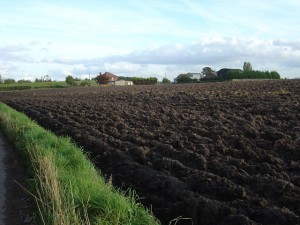Testing your soil is an important part of growing food- especially in areas with geologically old, nutrient-depleted, acidic soils as are commonly found in the Eastern United States.

Fall is the perfect time of year to get your soil tested to see what type and quantity of soil amendments you need to give your plants the nutrients they need without adversely affecting the soil or environment.
Application of too much nitrogen and phosphorus, for example, can leech into waterways and cause harmful algal blooms. These ‘blooms’ in turn cause an explosion of bacteria which result in low water oxygen levels, killing massive amounts of fish and has environmental effects all the way up the food chain. While important to plants, application of too much zinc, or too little or too much lime, can cause soil toxicity and limit availability of many other important nutrients. Having the right mix of nutrients will turn your garden into delicious abundance. Luckily, for North Carolina residents this testing is free April-November and Fifth Season Gardening in Carrboro now has soil test boxes that you can pick up to get the process started.

How to sample your soil properly:
1. Download and print a routine sample form (AD-1) to accompany your sample box(es): http://www.ncagr.gov/agronomi/forms.htm
2. Use a soil probe, spade, hand garden trowel, or shovel to collect samples. Do not use brass, bronze, or galvanized tools because they will contaminate samples with copper and/or zinc.
3. Choose a day when it is not raining or a time between waterings so that the soil is not too wet.
4. Sample from various parts of an area in a zigzag like fashion and make sure to keep samples from unique areas of your yard, garden or farm separate in their own box with a different sample ID (See Fig.01). The Farm & Sample IDs can be anything you’d like; just keep track of which sample ID matches which area and maintain the same Farm ID for each sample.
5. Remove any vegetation or mulch and dig down or probe through the first two layers of soil, about 4-8 inches (4 for undisturbed areas; 8 for plowed or double dug areas).
5. Mix the unique area zigzag samples in a clean, plastic bucket and put in properly labelled box.
 Tips on filling out your form: The form asks for the first crop and second crop for each corresponding box sample. First crop refers to the crop that you are growing presently or most recently including lawn (026) and second crop refers to the crop you wish to grow. Codes are on the second page. If the test is for a general annual vegetable garden use code 024. Be more specific for areas with blueberries and other perennials. For example, blueberries prefer more acidic soils and micro-nutient availability than most food crops while most annual vegetables thrive best in only slightly acidic soils with high macro-nutrient availability.
Tips on filling out your form: The form asks for the first crop and second crop for each corresponding box sample. First crop refers to the crop that you are growing presently or most recently including lawn (026) and second crop refers to the crop you wish to grow. Codes are on the second page. If the test is for a general annual vegetable garden use code 024. Be more specific for areas with blueberries and other perennials. For example, blueberries prefer more acidic soils and micro-nutient availability than most food crops while most annual vegetables thrive best in only slightly acidic soils with high macro-nutrient availability.
You’re ready to send in your test! Allow several weeks for processing. Once your soil test is complete, you will receive an email linking to the results. It will also be available online here: http://www.ncagr.gov/agronomi/pals/
For more information, see NCDA&CS Agronomic Services Soil Testing Information or visit us here at Fifth Season. We can help you interpret your results and figure out the amendments that will best serve your soil and fill your dinner plate!

Joel Dooris says
If I may be so bold to also say Biochar (a type of charcoal) added to the soil does amazing things over time. It acts as a substrate for beneficial fungi, it’s made of carbon so it forms weak hydrogen bonds with the nitrogen that is present in rain water(free renewable nitrogen for the plant), it also maintains the original “growth pattern” of whatever was chared. I have found that the best water retaining and best soil amendment input is just weeds from your yard. All those little capillary still intact absorb lots of water and the carbon provides a huge surface area for it’s size.
It’s easy to make. I use a beer can to make small amounts at a time in my fireplace. If I want to get nuts I use an old cookie tin with a hole in it.
Even the gas that is made when you cook it is useable. In world war two most of Europe used woodgas to run their internal combustion engines. To top it off the process to make biochar is carbon negative, in that you are storing carbon in a long term format (better then compost) directly into the soil.
I’m just a cheer leader for boichar and a lot of people still have yet to hear about it, so look into it and reap the benefits.
Sm hopkins says
Would Ashe from a pellet stove work as well? Thanks
Jeff Jackson says
I live in the Milwaukee area of Wisconsin and recently had a soil test done for a customer. I was surprised to see that the levels for potassium and phosphorus were very low to low. I am wondering if there is anyway that I could amend the soil to bring up the potassium and phosphorus levels. I know that they are both macro nutrients and are vital for plant growth.
I have done some research and another alternative that I found was possible lowering the pH level that is at 7.8 which is not to bad for our area. I would like to amend the soil with organic or environmentally friendly options if possible. If you have any suggestions I sure would appreciate it. Thank you for your time.
Sincerely
Jeff Jackson
Brandon Colman says
Jeff, thanks for commenting. Your question is a bit difficult to answer as an ideal soil amendment will address all your deficiencies without unduly raising the concentrations of other nutrients that are in the soil in adequate quantities. Having said that, sulfate of potash is recommended for raising K+ (potassium) levels at 0-0-50. Soft (also known as colloidal) rock phosphate is a good long-term option for phosphorous addition at 0-18-0. It is not soluble in water, though, so consider a high phosphorous guano for fast results. All of these products can be found in our webstore if you don’t have a convenient source locally.
Shanewon says
That’s a really nice blog with some important tips about Soil services. Thank you for sharing this post with all of us.
Rosie Beckett says
My husband and I have a large garden in our backyard and we are thinking about testing our soil. I had no idea that you should sample various parts of your soil in different areas and that you should choose a day when it is not raining so the soil is not too wet. Also, you make a great point that soil testing will show if there too many or too few nutrients because the right mix of nutrients will help our garden to thrive!